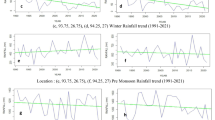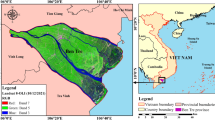Abstract
It is highly helpful and necessary to investigate and monitor the status of coal seam. Fortunately, remote sensing has facilitated the identification and dynamical monitoring of spontaneous combustion for a large area coal mining area, especially using the time series remotely-sensed datasets. In this paper, Datong Jurassic coal mining area is used as the study area, China, and an exclusion method and a multiple-factor analysis method are jointly used to identify the spontaneous combustion, including land surface temperature (LST), burnt rocks, and land use and land cover change (LUCC). The LST is firstly retrieved using a single-window algorithm due to a thermal infrared band of Landsat-5 TM (Thematic Mapper). Burnt rocks is then extracted using a decision-tree classification method based on a high-resolution SPOT-5 image. The thermal anomaly areas are identified and refined by the spatial overlay analysis of the above affecting factors. Three-period maps of coal fire areas are obtained and dynamically analyzed in 2007, 2009 and 2010. The results show that a total of 12 coal fire areas have been identified, which account for more than 1% of the total area of the study area. In general, there is an increasing trend yearly and a total of 771,970 m\(^{2}\) is increased. The average annual increase is 257,320 m\(^{2}\), the average annual growth rate is 3.78%, and the dynamic degree is 11.29%.







Similar content being viewed by others
References
André C, Ottlé C, Royer A and Maignan F 2015 Land surface temperature retrieval over circumpolar Arctic using SSM/I–SSMIS and MODIS data; Remote Sens. Environ. 162 1–10.
Gangopadhyay P K, Lahiri-Dutt K and Saha K 2006 Application of remote sensing to identify coal fires in the Raniganj Coal belt, India; Int. J. Appl. Earth Obs. 8(3) 188–195.
Hochstein M P and Dickinson D J 1970 Infra-red remote sensing of thermal ground in the Taupo region, New Zealand; Geothermics 2 420–423.
Hu X, Yang S, Zhou X, Yu Z and Hu C 2015 Coal spontaneous combustion prediction in gob using chaos analysis on gas indicators from upper tunnel; J. Nat. Gas Sci. Eng. 26 461–469.
Hu Z and Xia Q 2017 An integrated methodology for monitoring spontaneous combustion of coal waste dumps based on surface temperature detection; Appl. Therm. Eng. 122 27–38.
Inamdar A K, French A, Hook S, Vaughan G and Luckett W 2008 Land surface temperature retrieval at high spatial and temporal resolutions over the southwestern United States; J. Geophys. Res. 113(D7) D07107.
Jiang W, Jia K, Chen Z, Deng Y and Rao P 2017 Using spatiotemporal remote sensing data to assess the status and effectiveness of the underground coal fire suppression efforts during 2000–2015 in Wuda, China; J. Clean. Prod. 142 565–577.
Jiménez-Muñoz J C and Sobrino J A 2003 A generalized single-channel method for retrieving land surface temperature from remote sensing data; J. Geophys. Res. 108(D22) 4688–4696.
Liu J, Liu M, Zhuang D, Zhang Z and Deng X 2003 Study on spatial pattern of land-use change in China during 1995–2000; Sci. China Ser. D 46(4) 373–384.
Lu Y and Qin B 2015 Identification and control of spontaneous combustion of coal pillars: A case study in the Qianyingzi Mine, China; Nat. Hazards 75(3) 2683–2697.
Mansor S B, Cracknell A P, Shilin B V and Gornyi V I 1994 Monitoring of underground coal fires using thermal infrared data; Int. J. Remote Sens. 15(8) 1675–1685.
Mishra R K, Bahuguna P P and Singh V K 2011 Detection of coal mine fire in Jharia Coal Field using Landsat-7 ETM+ data; Int. J. Coal Geol. 86(1) 73–78.
Nelson M I and Chen X D 2007 Survey of experimental work on the self-heating and spontaneous combustion of coal; Rev. Eng. Geol. 18 31–83.
Oppenheimer D H 1986 Extensional tectonics at the Geysers geothermal area, California; J. Geophys. Res. 91(B11) 11463–11476.
Pal S K, Vaish J, Kumar S and Bharti A K 2016 Coal fire mapping of East Basuria Colliery, Jharia coalfield using vertical derivative technique of magnetic data; J. Earth Syst. Sci. 125(1) 165–178.
Politi E, Cutler M E and Rowan J S 2012 Using the NOAA advanced very high resolution radiometer to characterize temporal and spatial trends in water temperature of large European lakes; Remote Sens. Environ. 126 1–11.
Prashanthi S K and Kulkarni S 2005 Coal-fire detection and monitoring in Raniganj coalfield, India – A remote sensing approach; Curr. Sci. 88(1) 21.
Price J C 1984 Land surface temperature measurements from the split window channels of the NOAA 7 Advanced Very High Resolution Radiometer; J. Geophys. Res. 89(D5) 7231–7237.
Qin Z, Karnieli A and Berliner P 2001 A mono-window algorithm for retrieving land surface temperature from Landsat TM data and its application to the Israel–Egypt border region; Int. J. Remote Sens. 22(18) 3719–3746.
Ren X W, Wang F Z, Guo Q, Zuo Z B and Fang Q S 2015 Application of foam-gel technique to control CO exposure generated during spontaneous combustion of coal in coal mines; J. Occup. Environ. Hyg. 12(11) D239–D245.
Rosema A, Guan H and Veld H 2001 Simulation of spontaneous combustion, to study the causes of coal fires in the Rujigou Basin; Fuel 80(1) 7–16.
Saraf A K, Prakash A, Sengupta S and Gupta R P 1995 Landsat-TM data for estimating ground temperature and depth of subsurface coal fire in the Jharia coal field, India; Int. J. Remote Sens. 16(12) 2111–2124.
Singh A, Raju A, Pati P and Kumar N 2017 Mapping of coal fire in Jharia Coalfield, India: A remote sensing based approach; J. Indian Soc. Remote 45(2) 369–376.
Song Z, Kuenzer C, Zhu H, Zhang Z, Jia Y, Sun Y and Zhang J 2015 Analysis of coal fire dynamics in the Wuda syncline impacted by fire-fighting activities based on in-situ observations and Landsat-8 remote sensing data; Int. J. Coal. Geol. 141 91–102.
Srivastava P K, Han D, Rico-Ramirez M A, Bray M, Islam T, Gupta M and Dai Q 2014 Estimation of land surface temperature from atmospherically corrected LANDSAT TM image using 6S and NCEP global reanalysis product; Environ. Earth Sci. 72(12) 5183–5196.
Stracher G B and Taylor T P 2004 Coal fires burning out of control around the world: Thermodynamic recipe for environmental catastrophe; Int. J. Coal Geol. 59(1) 7–17.
Wang C, Yang Y, Tsai Y T, Deng J and Shu C M 2016 Spontaneous combustion in six types of coal by using the simultaneous thermal analysis–Fourier transform infrared spectroscopy technique; J. Therm. Anal. Calorim. 126(3) 1591–1602.
Wan Z, Zhang Y, Zhang Q and Li Z L 2004 Quality assessment and validation of the MODIS global land surface temperature; Int. J. Remote Sens. 25(1) 261–274.
Xue S, Dickson B and Wu J 2008 Application of \(^{222}\)Rn technique to locate subsurface coal heatings in Australian coal mines; Int. J. Coal Geol. 74(2) 139–144.
Zhang J, Wagner W, Prakash A, Mehl H and Voigt S 2004 Detecting coal fires using remote sensing techniques; Int. J. Remote Sens. 25(16) 3193–3220.
Acknowledgements
This work was financially supported by National Key Research and Development Program of China (2016YFD0800904).
Author information
Authors and Affiliations
Corresponding author
Additional information
Corresponding editor: Piyush Shanker Agram
Rights and permissions
About this article
Cite this article
Xue, Y., Liu, J., Li, J. et al. Use of Landsat thermal imagery for dynamically monitoring spontaneous combustion of Datong Jurassic coalfields in China. J Earth Syst Sci 127, 47 (2018). https://doi.org/10.1007/s12040-018-0952-1
Received:
Revised:
Accepted:
Published:
DOI: https://doi.org/10.1007/s12040-018-0952-1




